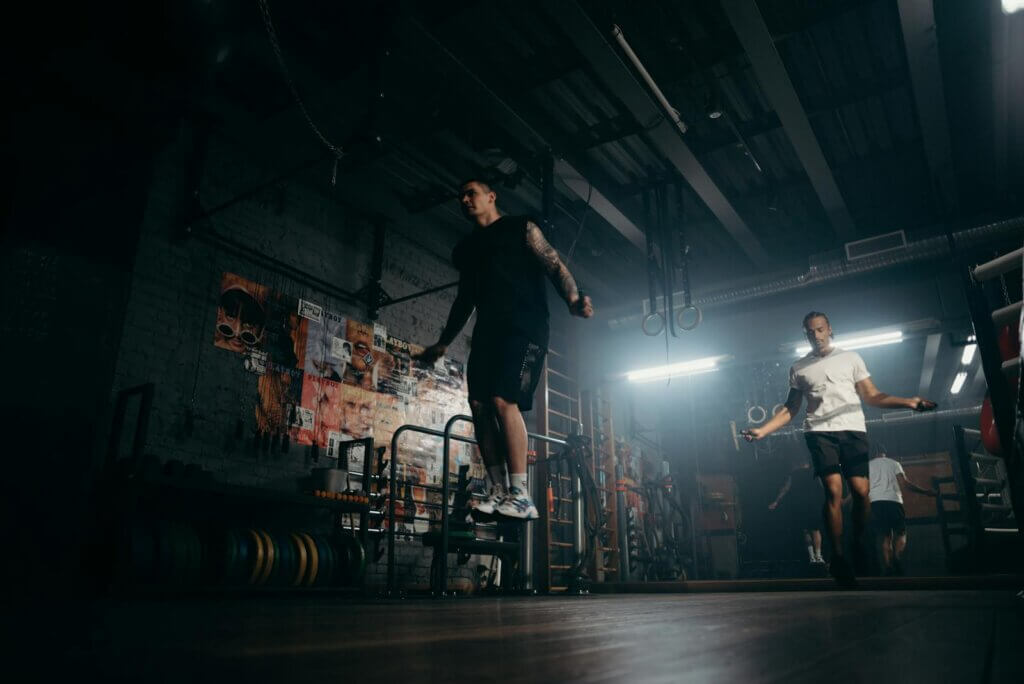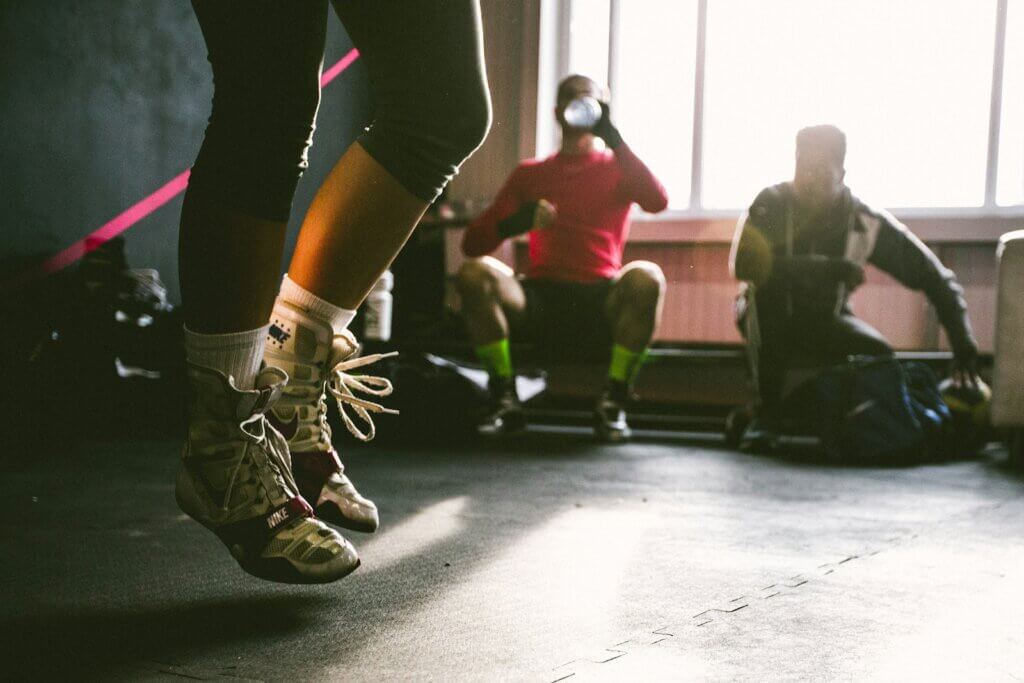How to do Double Unders

Introduction:
Double unders are a staple in CrossFit and functional fitness routines, known for their ability to significantly boost cardiovascular endurance, coordination, and agility. This advanced jump rope exercise involves passing the rope under your feet twice during a single jump, requiring speed, timing, and precision. Whether you’re looking to enhance your workout intensity or challenge your coordination, mastering double unders is a rewarding skill that can take your fitness to the next level. In this guide, we’ll break down the steps to perform double unders, the necessary equipment, scaling options, common mistakes, and the benefits of incorporating this exercise into your routine.
Steps in the Double Under movement
Setup:
- Stand upright with feet hip-width apart.
- Hold the jump rope handles with a relaxed grip, keeping your elbows close to your sides.
- Ensure the rope is behind your heels, ready to start.
Initiate the Jump:
- Start with a few single unders (regular jumps) to establish a rhythm.
- Jump off the balls of your feet, keeping your jumps small and controlled.
Increase Rope Speed:
- Begin to spin the rope faster using your wrists, not your arms.
- Aim for quick, efficient rotations to prepare for the double under.
Perform the Double Under:
- Jump slightly higher than a regular single under.
- Spin the rope quickly, passing it under your feet twice before landing.
- Keep your core tight and body upright, minimizing unnecessary movements.
Continue the Movement:
- Land softly on the balls of your feet and immediately jump into the next repetition.
- Maintain a consistent rhythm and controlled breathing to sustain multiple double unders in a row.
What Equipment is needed
- Jump Rope: A speed rope designed for quick rotations and durability.
- Appropriate Footwear: Cross-training shoes that provide support and cushioning for jumping.
Choosing the Right Jump Rope for Double Unders
Selecting the appropriate jump rope is vital for success in double unders. Speed ropes are generally recommended due to their lightweight design and rapid rotation capabilities. When choosing a rope, consider the material of the cable; coated steel cables offer durability and speed, making them ideal for this exercise. Handle design is equally important; ergonomic, lightweight handles with smooth swivel mechanisms enhance control and reduce wrist fatigue. Additionally, rope length plays a critical role. A general guideline is to choose a rope that, when stood upon, reaches close to your armpits. Some athletes prefer custom-length ropes tailored to their specific measurements for optimal performance. Investing in a high-quality rope that suits your individual needs can significantly impact your double under proficiency.
Check out the Equipment subsite for more tools, tips, and inspiration.

Shop Fitness gear now on Amazon
See Amazons extensive range of workout gear here. (Affiliate Link)
Scaling Options:
To gradually build strength and proficiency, consider the following scaling options:
- Single Unders: Practice regular jump rope movements to build coordination and timing.
- Single-Single-Double: Alternate between two single unders and one double under to gradually increase proficiency.
- Double Under Attempts: Practice attempting double unders with single unders in between to build confidence and skill.
Common Mistakes to Avoid:
- Incorrect Rope Length: Ensure the rope is the right length by standing on the middle and pulling the handles up—they should reach your armpits.
- Excessive Arm Movement: Use your wrists to spin the rope, keeping your arms and shoulders relaxed.
- Jumping Too High: Focus on quick, controlled jumps just high enough for the rope to pass under twice.
- Poor Timing: Practice single unders to establish a rhythm, then gradually increase speed for double unders.
Benefits of the Movement:
- Cardiovascular Endurance: Elevates heart rate, improving overall cardiovascular fitness.
- Coordination and Agility: Enhances timing, rhythm, and neuromuscular coordination.
- Full-Body Workout: Engages multiple muscle groups, including the legs, core, and upper body.
- Caloric Burn: High-intensity nature leads to significant calorie expenditure.

Which Muscles Are Worked:
During this exercise, the following muscle groups are engaged:
- Primary Muscles: Calves, quadriceps, hamstrings, glutes.
- Secondary Muscles: Core stabilizers, shoulders, forearms.
Alternative Similar Movements:
If you’re seeking variation or targeting specific muscle groups, consider incorporating these alternative exercises:
- Single Unders: Basic jump rope technique to build foundational skills.
- High Knees with Rope: Adds intensity by incorporating high knees into jump rope movements.
- Criss-Cross Jump Rope: Involves crossing arms while jumping to challenge coordination.
- Box Jumps: Explosive movement that also improves lower body power and coordination.

Shop Fitness gear now on Amazon
See Amazons extensive range of workout gear here. (Affiliate Link)
Progression Techniques for Mastering Double Unders
Mastering double unders can be challenging, especially for beginners. Implementing a structured progression can facilitate skill acquisition and build confidence. Start with single unders to establish a consistent rhythm and proper form. Once comfortable, progress to alternating between single and double unders—performing one double under followed by several single unders. This method allows you to maintain momentum while gradually introducing the more complex movement. As proficiency increases, reduce the number of single unders between double unders until you can perform consecutive double unders seamlessly. Consistent practice, patience, and focusing on wrist speed and minimal jump height are crucial throughout this progression. Incorporating these steps can lead to efficient mastery of double unders.
Common Injuries and Prevention Strategies
While double unders are an effective cardiovascular exercise, they can pose injury risks if not performed correctly. Common injuries include shin splints, calf strains, and foot discomfort, often resulting from improper technique or overtraining. To prevent these issues, ensure proper warm-up routines that include dynamic stretching and calf activation exercises. Focus on landing softly on the balls of your feet to reduce impact stress. Maintaining an upright posture and engaging your core can also alleviate undue strain on the lower body. Gradually increasing training intensity allows your body to adapt and reduces the risk of overuse injuries. Listening to your body and incorporating rest days as needed are essential practices for injury prevention.
Integrating Double Unders into Your Workout Routine
Incorporating double unders into your fitness regimen can enhance cardiovascular endurance, coordination, and agility. Begin by adding them to your warm-up to elevate heart rate and prepare the body for more intensive exercises. As proficiency improves, include double unders in high-intensity interval training (HIIT) circuits to maximize calorie burn and cardiovascular benefits. Pairing double unders with strength exercises, such as squats or push-ups, in a circuit format can provide a comprehensive full-body workout. Additionally, using double unders as a finisher at the end of your workout can improve muscular endurance and mental toughness. Adjust the volume and intensity based on your fitness level to ensure safety and effectiveness.
Q&A for Double unders
How do you do double unders?
Double unders involve jumping slightly higher than for single unders and spinning the rope fast enough to pass under your feet twice before landing. Consistent practice and focusing on wrist speed are key.
Why can’t I do double unders?
Difficulty with double unders often comes from improper timing, jumping too high, or not spinning the rope fast enough. Practice single unders and gradually increase speed to improve.
Do you jump higher for double unders?
Yes, you need to jump slightly higher than for single unders to give the rope enough time to pass under your feet twice.
Are double unders hard?
Double unders can be challenging because they require precise timing, coordination, and speed. However, with practice, they become easier.
How long should 100 double unders take?
The time to complete 100 double unders varies by individual, but an average time is around 1-2 minutes for those proficient in the movement.
How to breathe during double unders?
Maintain a steady breathing pattern, exhaling on each jump. Avoid holding your breath to ensure consistent performance and endurance.
Do double unders build muscle?
While primarily a cardiovascular exercise, double unders engage and tone muscles in the legs, core, and shoulders, contributing to muscle endurance and definition.
How often should I practice double unders?
Practicing double unders 2-3 times a week is sufficient to build proficiency without overtraining. Include them in your warm-up or as part of a cardio routine.
What is the advice for double unders?
Focus on wrist speed, stay relaxed, and keep your jumps low and controlled. Practice consistently and be patient with your progress.
How to relax when doing double unders?
Stay calm and focus on your breathing. Use your wrists rather than your arms to spin the rope and keep your body loose to reduce tension.
How can I be more efficient with double unders?
Efficiency comes from quick wrist movements, minimal arm involvement, and low, controlled jumps. Consistent practice and proper form are crucial.
How do you judge double unders?
In CrossFit, a double under is counted each time the rope passes under your feet twice in a single jump. Judges look for clear double rotations before landing.
Should I jump rope for 20 minutes straight?
Jumping rope for 20 minutes straight is a good cardiovascular workout but can be intense. Break it into intervals if you’re new to jump rope exercises.
What is the best rope for double unders?
A speed rope designed for quick rotations and durability is best for double unders. Look for adjustable lengths and lightweight handles for optimal performance.
Conclusion:
Mastering double unders can be a challenging yet highly rewarding addition to your fitness routine. With dedication and consistent practice, you’ll be able to enhance your cardiovascular endurance, coordination, and agility, making this exercise a valuable component of your overall training regimen. Grab your jump rope, find your rhythm, and start mastering the art of the double under today!

Shop Fitness gear now on Amazon
See Amazons extensive range of workout gear here. (Affiliate Link)
